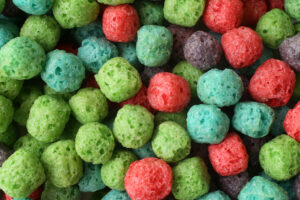How are natural colors made?
Just like how natural colors come from a wide variety of places, they can also be made in a number of different ways. A lot of how a natural color is manufactured is based on whether the pigment is oil soluble or water soluble.
The different solubilities require different methods for removing the color from the natural source. Extraction methods can also vary based on how the color is contained within the source – whether the color is on the exterior part of the crop, in the flesh, or part of the seed. We’ll talk about the different types of extraction below. After extraction, the colors are concentrated for maximum vibrancy with low use rates.
Water Soluble Natural Colors
Juicing, Griding, & Crushing
When the color is water soluble and is contained within the fruit of the source – like with red beets or purple carrots – physical methods, such as juicing by crushing or grinding, are most commonly used. In this processing, the beets or carrots are run through a machine that crushes them until all the juice is extracted. The juice can then be concentrated down to different levels and either kept in liquid form or sent on to a dryer to make powders.
Water Extraction
When the color lies on the outside of the natural source, like with purple corn, carmine, and spirulina, water extraction is a great option. In this process the natural source is soaked in water. Since the pigment is water soluble, it easily dissolves, creating a colorful liquid that can then be concentrated to different levels using an evaporator. Similar to the grinding or crushing method, these colors can then be sent on for drying or be kept in liquid form.
You can see this method in action by watching our video on how we make our Amaize® Red.
Oil Soluble Natural Colors
Solvent Extraction
Oil soluble pigments, such as beta carotene, annatto, paprika, and turmeric, are typically found within the plant/organism, and often require what is called ‘solvent extraction’ in addition to crushing or grinding.
The first step is to crush or grind the source. A solvent is then used to separate the pigment from the plant because the pigment isn’t able to dissolve in water. While the word solvent may sound scary – don’t worry – the solvent can be as simple as vegetable oil or alcohol which can be used to dissolve oil-based pigments (water is the ‘solvent’ in water extraction). These can also include several stronger organic solvents that are approved for use in food.
Like the water soluble natural colors, once the color has been obtained, the solvent is evaporated out, and the color is diluted to different color strengths.
Whichever type of method is used, it is important to extract and concentrate the color as soon as the pigment has been disturbed (such as by crushing) in order to maintain peak quality and vibrancy.






